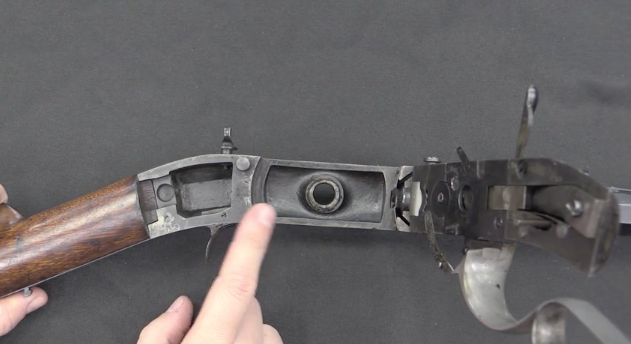These are lots #1050 (top-loader) and #3077 (bayonet fitted) in the upcoming RIA Premier Auction. It was scheduled for April, but has been postponed – check their web site for upcoming Online Only auctions every month, though!
Andrew Burgess is an underappreciated arms designer, and his Model 1878 (aka the Whitney-Burgess-Morse) had the potential to be a very serious competition to Winchester. It was chambered for the .45-70 Government cartridge, and unlike the Winchester 1876 Burgess’ design could handle to power of that round. However, a series of misjudgements led to production ending after less than two years. The first problem was unreliability of the lifter mechanism as originally produced. This was a primary cause of the rifle failing the 1878 military repeating rifle trials, but Whitneyville had finalized the production tooling without waiting to see the trial results. Thus the first thousand or so guns shipped to customers tended to have double feeds. In addition, it was discovered that UMC cartridges had very sensitive primers that would detonate in the magazine tube with enough regularity to be a serious problem. This was addressed by UMC offering a special loading for the Burgess, but this was done only after the problem gained some publicity.
The Burgess 1878 was offered as both a military carbine and a sporting rifle, and we have a pair of military carbines to show you today. One is a first model that loads from the top (extraordinarily rare) and the other is a third model with a bayonet lug (also extremely rare). The guns were initially offered in both top- and side-loading configurations, and the side-loading was so overwhelmingly preferred that virtually all the top-loaders were adapted to the side-loading pattern.




Does the phrase “live fire testing” mean nothing to people before they actually start main-line production!?
I think that everything was normal in military tests.
All problems began due to non-standard cartridges.
Exemplary review!
Very interesting.
Merci beaucoup Yen.
Only, it is a pity that it was not possible to look into the guts … (?)
All the guts are basically on the lever apart from the cartridge lifter. The breech face is very long and the firing pin transfer pin and block in the lever tucks in behind it. This acts as an out of battery safety as the firing pin and transfer pin and hammer only align when the breech is fully locked. They in my opinion are wonderful shooters, at least in the 3rd type, which is the only one I posses. The Kennedy in 44 /40 is even nicer. Makes a Winchester 86 or 92 feel positively agricultural.
Thanks.
Here, a not entirely clear mention.
https://books.google.com.ua/books?id=q7alth3j840C&pg=PA766&lpg=PA766&dq=US+patent+168,966+1875&source=bl&ots=m2vI0Z3Wca&sig=ACfU3U1lb8TvnXQVVF6CwRcqX9Oi0q581g&hl=en&sa=X&ved=2ahUKEwj07MDjuNvoAhWpAxAIHRcRC_QQ6AEwAHoECA0QKA#v=onepage&q=US%20patent%20168%2C966%201875&f=true
And now, it’s clearer.
https://photos.google.com/album/AF1QipONvIfdO3J_d51dLIJkLwPv8_YYU2Wv0-kYk4-n
Interesting system.
Pretty simple and almost completely protected from dirt.
But it seems that subsequently, he had to switch to straight bolt guides.
https://photos.app.goo.gl/Ga4JduTC4zzCQrz29
Sure looks like a lot of Burgess system was included in John Moses Browning’s 7 Aug. 1883 U.S. Patent No. 282,839 “Magazine Gun.” Particularly the lever and firing pin mechanisms.
I have a Burgress rifle I think but it has a hex barrel its s derelict barn find does any body know about it thanks